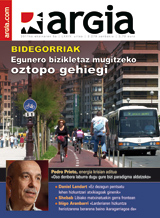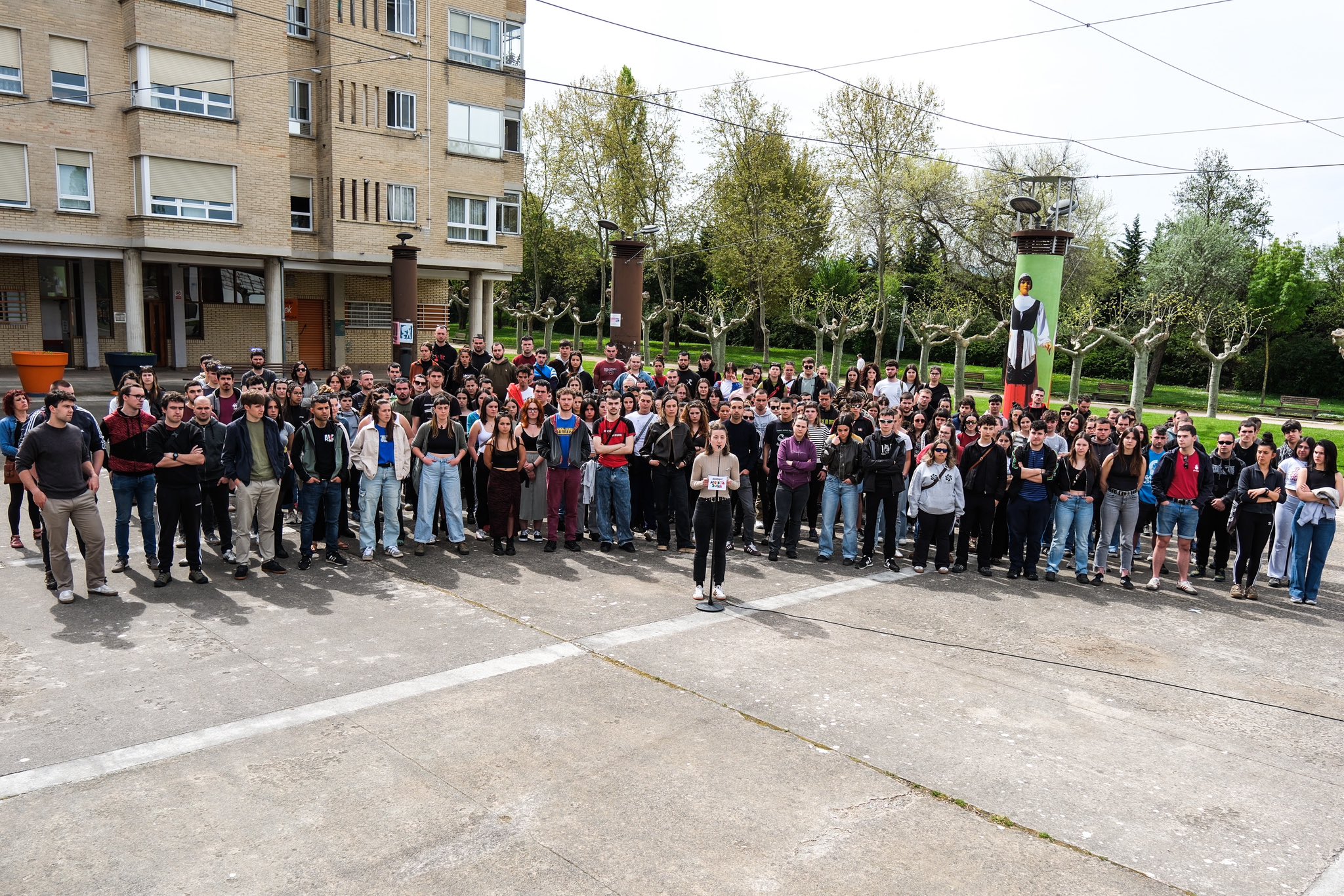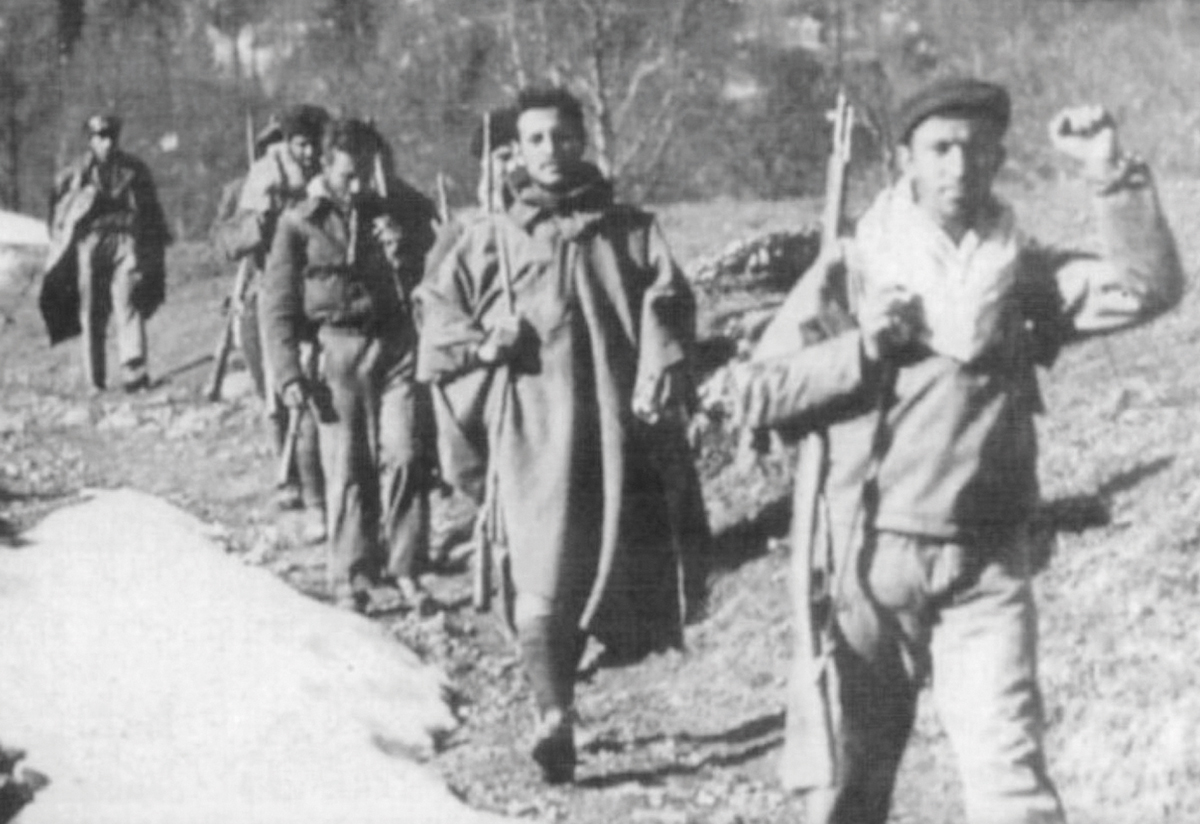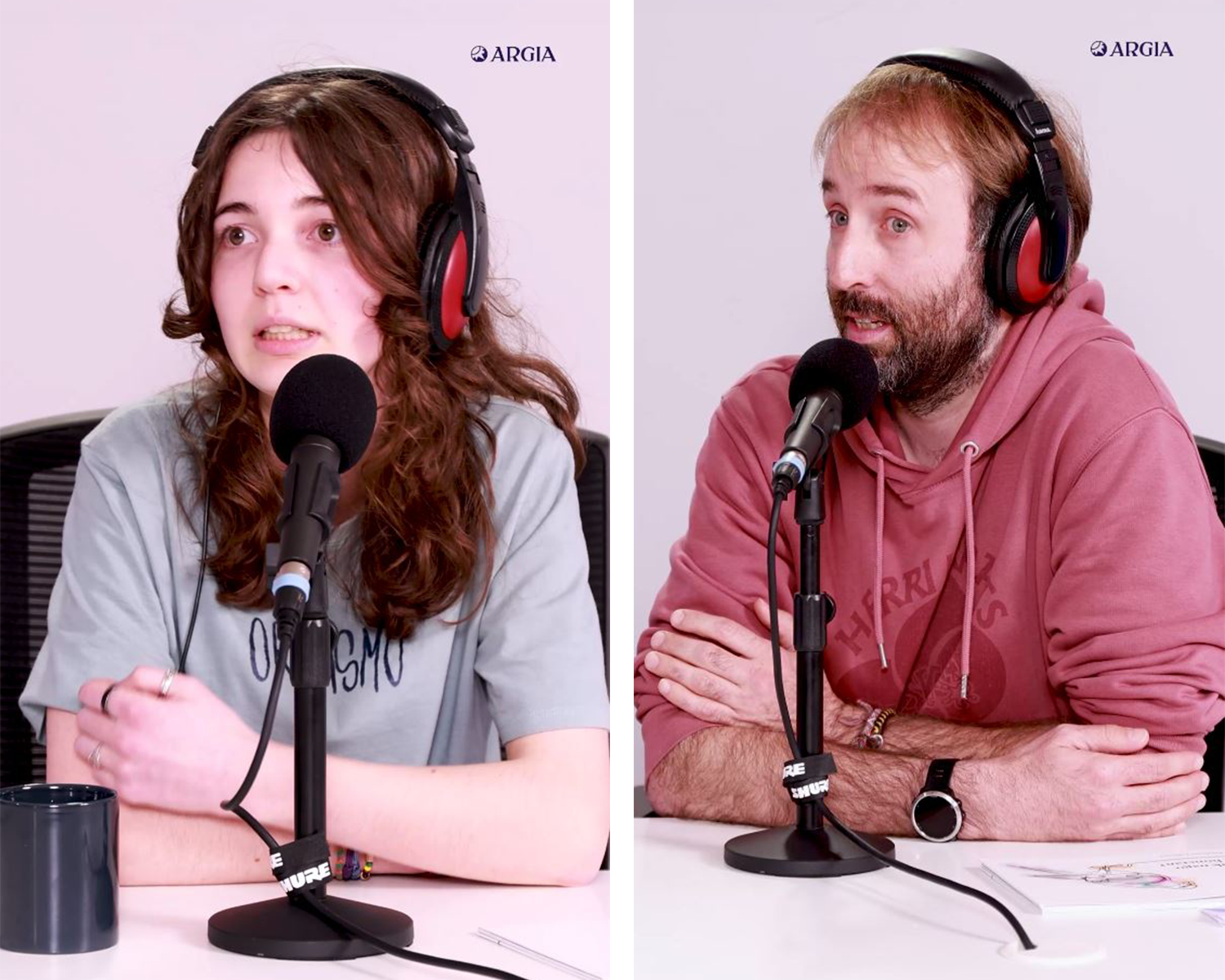Miles Not Well Linked
- More and more people are cycling to achieve a coherent and useful network of daily mobility needs erantzuteko.Bidegorri, however, if more solid steps are not taken, it is unlikely that the bicycle will be able to replace the car to the extent necessary.
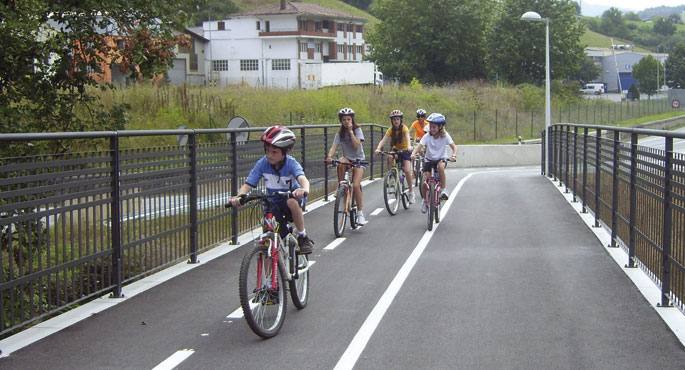
I'll admit it. Recently, I sent him with his left arm to pick us up from the stern, the firecracker car driver who was asking us to enter the five-centimeter shepherd. The members of the platoon expressed their outrage in a more graphic way, and on the winding road that goes up the Urola River we had a sound of horns gregarious for a while.
I'd have thought, my good driver, that these fuckin' cyclists were going on the bike path across the river instead of interfering with the running of motor vehicles. By this route, however, at least in the largest section, it is not possible to ride the road bike because the floor is unpaved. Otherwise, we would hardly go there, because avoiding cyclists and pedestrians and runners who are slower than us is not pleasant, neither for us nor for the rest of the users of the bike lanes.
We ride our bikes to do sports, among animals of the same species that go out on the road in balance at this time of year, as if we were training to win the Tour de France. And it is clear that for the challenge of size the network of bike lanes in the Basque Country falls very short. However, in order to promote the use of bicycles, the goal should not be to satisfy the mileage of these predators. At least not the main goal. It is possible that some of you take the bike to enjoy your free time in a more relaxed way, and in this case, an increasingly wide network of bike lanes is gradually adapting to the needs of users thanks to the infrastructures of the road that goes from Zumarra to Peralta.
It’s also likely that someone will use the bike all year round to go to work and school, do errands, go out for drinks and make other moves that your daily life usually requires. In this report we will talk in particular about the experience of this type of users. The cyclists we interviewed say that progress has been made, but that there have often been actions to show a pompous appearance, and that there are still many things to improve, so that in daily practice the bicycle can become a real alternative to motor vehicles.
Kilometres of fiction
The blogger, Areilza do(k)tore, is a technical company working 10 kilometres from Bilbao: “Except for going to the office, I use my bike for everything. Because of the distance I could try to go back and forth by cycling, because from the point of view of mobility I find a route of up to ten kilometers acceptable, but I would have to travel in the dark and the road is too dangerous.” In his own words, “In Greater Bilbao there is no easy way to get around by bike. From a distance it would be possible to connect Getxo, Barakaldo and Gezierri with Bilbao via bike lanes or non-motorway roads, but nowadays it is almost impossible to talk about mobility”. In the Bilbogorre blog, he posts photographs of the Bilbao bike network to highlight its shortcomings. When asked about the city’s policy, he replied that the progress that is being made is not enough: “It’s okay to label it green and green, it sells a lot, but the authorities don’t believe in it. They make bike lanes when they don’t know what to put in a new building.”
Carlos Ormazabal, Deputy for Sustainable Development of the Provincial Council of Gipuzkoa, answers that the bike lane is an issue on the agenda of the projects: “The spaces that exist when designing the bike path must be designed in the best possible way, filling empty spaces or adapting old tracks and tracks, for example.”
The managers of the blog Errores y horrores del carril bici en Pamplona (http://erroresyhorrores.blogspot.com) talk about the cycle paths of their city in terms similar to those of Areilza do(k). They say that the policy of the City Council of Pamplona is “deplorable”: “We believe that decisions are made by people who do not know the needs of cyclists and pedestrians, who have probably never ridden a bike in Santa. We have the supports of municipal rental bicycles (nbici) as an example; there are only five throughout the city. The authorities extend the steps to four winds, but they often talk about the number of fictitious kilometers that do not exist, taking as a bicycle route the pedestrian trails of river parks and universities. These steps are not prepared for bicycles, they have insurmountable obstacles that hinder the relationship between pedestrians and cyclists... If we were to count the kilometres adapted for bicycles, the quality of the Pamplona network would probably be at the back of the peloton in any serious classification”.
The roads in Pamplona are not connected to each other. “This is the biggest shortcoming; they don’t allow you to move around the city in a comfortable and safe way. In the Old Town and the Second Esplanade, for example, there are no roads for bicycles”, they complain.
Lack of continuity as an obstacle
Bilbao has the same problem. “It is true that things are being done, but many parts are not connected,” Areilza tells us. He also says that it is worrying that there is no connection to cycling from the capital to nearby towns: “It is especially sad to see that there are unfinished bike routes on both sides of the river.” As a positive example, he gave us the greenway of Galdames and the bike lanes around Muskiz-Areeta-Barakaldo and Getxo, but he said that they were mainly made for recreation. Green roads are bicycle routes built on the site of the old railways. There are a dozen in the South Basque Country.
Iban Grossier, whose head office is in Bayonne, tells us what he said. members of the movement's Alternatives to the Car. “The characteristics of the Northern Basque Country’s cycling network are as follows: they are not designed in a continuous fashion – they have ‘cutouts’ inside them, roundabouts... – and they have no connection between them, the network lacks coherence. There is a lack of a general scheme that would be organized for the cyclist, especially for the urban center of Bayonne and in the general mold for the whole North.”
We are more optimistic about Rubén Ziordia, from the group Bicycles of Vitoria-Gasteiz, whose objective is to guarantee the rights of bicycle users: “The first bike lanes, made in the 1980s, were scattered around the city, not connected to each other, and were hardly used. From the year 2000, thanks to the work of our association and the City Council, this initial network was expanded and some logical routes were completed. The aim of the first bike lanes was to meet the needs of leisure, but today they are able to respond to everyday mobility. Vitoria-Gasteiz is a very compact city and has been linked from side to side. The goal is that 15% of all daily movement is done by bicycle. The figure is now around 3%.” In San Sebastian, according to data provided by the City Council, the number of bicycle movements within the city is 3.5%, although the target for 2011 was to reach 6%. The Association of Cyclists of the City of Kalapie recognizes that in the last ten years San Sebastián has developed an active policy in favor of cycling, but they add that mainly pedestrians and public transport users have passed on to cycling, while motor vehicles have increased on the contrary.
Our interviewees have told us that in general the condition of the bike lanes is good, although some of them have suffered shortcomings: they invade the sidewalks, the indentation of the edge is too large, they have trees and road signs on their sides, as well as wooden barriers, pivots and car parks –with the risks that this entails, such as opening the door suddenly and hitting a cyclist–, they are badly signposted, the speed limit is extremely low. According to Grossier, “the areas marked for cyclists on the side of the road are too narrow in smell and sometimes made next to roads with too much car traffic.”
Prefer from the road
You've got to live! According to the movement’s Citizen Cycling Diagnosis report in the spring of 2010, of the 1,126 cyclists who answered the questions, 9.2% said that the behavior of car drivers is good with respect to them, 52.5% intermediate and 35.8% bad. Grosier uses his bike every day: “I know that motorists are on the road.” In the opinion of the Pamplona bloggers, many car drivers do not know the rules of circulation, such as the safety margin to be maintained (1.5 meters). “On the other hand, the problem with pedestrians is that the spaces for each one assume each other and there is no room for everyone,” they explain.
Ziordia reminds us that we must pay attention to the signs of the bike lanes, because they will tell us who has priority, what are their rights and obligations. And to learn this, it also belongs to the cyclists who do not pay attention to the red traffic lights to avoid breaking the rhythm. There are some blue signs on the bike lanes that indicate exclusivity, but do not force the cyclist to go there, explains the member of the Bicyclists association. He is a civil servant and works in the centre of Vitoria: “Sometimes I prefer to go on the road because the traffic code and signs are on my side. ‘Hey, you have to go by bike lane!’ car drivers yell at me. That's not true. It is possible that only cyclists can ride this bike path, but we are not obliged to do so.” Many local police, on the other hand, don’t care what’s left in the bike lanes.
“We are also traffic and we have to proclaim that, bicycles are also vehicles”, adds the Areilza do(k)tore. “If cars can choose highways or ordinary roads, why not when we have two options? Cars ‘knock’ cities out almost every day, but bicycles are considered unacceptable to slow their pace. Cars have the right to ‘hit’ cities, but bicycles don’t.”
For the Bilbao cyclist, “bike lanes only hinder the normal use of bicycles”. When asked about the reasons, he answers that segregation has both pros and cons. In his words, bike lanes are important to promote the use of bicycles: “For children and novice users to pedal in the estreina, to avoid traffic at the exit entrances of large cities, to walk...” But he also says that a false idea gains strength: “Road for cars, bike path and sidewalk for pedestrians.” The solution is to share the space, because making two road networks (one for bicycles, the other for cars) is a “huge waste of money”: “It is not possible to maintain two networks, both economically and technically, so why not start facilitating the use of bicycles in cities? Tightening roads and limiting the speed of cars, reducing parking lots and, in general, ‘obstacles’ to cars in urban areas.”
Public transport(s) as a complement
Like Ziordia, Areilza often chooses the side of the road. “This is the fastest way to travel, using bike lanes as a variant to avoid the opposite directions. Also more comfortable, except on weekends, for the snails that fill the road: children, grandparents, skaters... It becomes a ginkana to walk on bike lanes,” he says ironically. The road is also safer for them, but he acknowledges that he has experience and is used to walking between cars. Iban Grossier has no doubt: “It is clear that cycling in the North and especially in the urban area of Bayonne is very dangerous. The car is much safer.”
You've got to live! For the member of the collective, the bicycle and public transport complement each other: “For example, cycling should allow one to go to the bus stop or train station next to the house. Or, when we get off the bus or train, we could take a freely usable bicycle. By bike, bus, train... the idea is to leave the car in the parking lot or in the garage. Or better yet, no car.” Grossier says that the car’s protagonism is “overly important”, but after several years of sleep, the elected officials have finally awakened and are working towards a mobility policy that is already underway in other urban centers and regions. The authorities should set an example: “They should be the first to pick the bike instead of the car, as often as they can!”
“It’s up to you to decide which option to opt for for your mobility,” says Carlos Ormazabal, Deputy for Sustainable Development of Gipuzkoa, when asked how to deal with car addiction. He says that the Provincial Council is making efforts to form an appropriate network based on public transport, but that we have a “deeply embedded” culture of using a motor vehicle: “Without excluding the private vehicle, the challenge for all citizens will be to bet on electric vehicles, but that will come with time.” Linking urban areas with industrial areas through bike lanes is a priority for the Diputación because “to promote portable mobility it is essential to be able to go to work places by bicycle”. Given the distance many of us have from the workplace, it is imperative that bicycles and public transport create a true partnership. As well as connecting the municipalities with bicycle paths, which during peak hours can make the traffic extremely difficult to travel.
89 urterekin hil da, Liman, eta idazle perutarraren seme-alabek eman dute haren heriotzaren berri. Gaztelaniazko literaturaren egilerik ospetsuenetakoa izan zen, eta 1960ko eta 1970eko hamarkadetan Latinoamerikan literaturak izan zuen loraldian paper garrantzitsua jokatu zuen... [+]
Euskal Herriko Kontseilu Sozialistak (EHKS) antolatuta, egun osoko jardunaldia egin dute igandean, Bilboko Campos Eliseos antzokian. Hainbat hitzaldik osatu dute egitaraua, eta jardnualdia amaitzeko Bigarrenez Aresti etorkizunaren aurrean antzezlana estreinatu dute.
Bozen lehen itzulian pare-parean geratu ostean, inkesta gehienek aurreikusten zutena baino tarte handiagoa atera dio egungo presidenteak Luisa González hautagai correistari. Oposizioak "iruzurra" salatu eta botoak berriz zenbatzea eskatu du.
Gure amak beti esaten du: “Ez dut sekula ulertu zergatik gertatu zen Lehen Mundu Gerra”. Ez dio batere zentzurik harrapatzen. Ez du ulertzen zergatik inplikatu ziren Europako potentzia zaharrak halako basakeria batean eta ez zaio buruan sartzen nola konbentzitu... [+]
Adierazpen askatasuna aldarrikatzeko eta "eskuin erreakzionarioaren ofentsibari aurre egiteko" batuko dira. Egun horretarako Euskal Preso Politikoen alde antolatua zuten hitzaldia eta ekitaldia salatu du UPNk, eta hura zelatatzeko agindu du Espainiako Audientzia... [+]
Maki gerrillari antifrankistek Euskal Herrian ez zuten presentzia bereziki nabarmena izan, baina batzuk pasatu ziren, baita erregimenaren errepresio bortitza pairatu ere. Guardia Zibilak hiru hil zituen Ibaetan 1947an eta bat Zubietan 1948an, ahaztuta badaude ere.
Ekimenak bakea eta justizia soziala sustatzeko proiektuak finantzatzea du helburu. Sustatzaile diren gizarte mugimenduek mezu argi bat bidali diete gobernuei eta armagintza industriari: "Ez dugu gerraren konplize izan nahi".
"Ask for your turn and we'll join you," the willing and cheerful announcer who speaks from the studios tells the young correspondent who walks through the streets of Bilbao. The presenter immediately addressed the audience. "In the meantime, we are going to Pamplona..." They opened... [+]
At the beginning of the year, the Zedarria group publicly supported the "opening of the debate" on the "defense" industry (as well as the nuclear industry), to which the Basque Government has immediately joined. First, through Mikel Torres, Vice President and Economic Counselor, who... [+]









